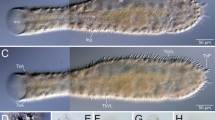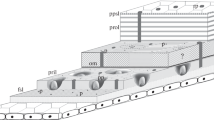Summary
The fine structure of freshly shed cuticles ofPeriplaneta americana (L.) was revealed from replicas and thin sections. Only the middle parts of pronota were investigated since these had been used previously in permeability studies. The cuticle is subdivided into the procuticle and the epicuticle, the latter consisting of four layers: (1) dense layer, (2) cuticulin layer, (3) wax layer and (4) cement layer.
The whole structure is penetrated by numerous pore canals which provide pathways between the internal and external faces of the cuticle. In the basal region of the procuticle the pore canals vary in diameter, whereas more distally,i.e. in the apical region of the epicuticle, the diameters become more uniform measuring 150–300 Å. Close to the outer cuticle surface the pore canals possess a 50 Å thin plate which is probably perforated. Wax canals are lacking. On the average 15 pore canals per μ2 cuticular surface were counted inPeriplaneta. The corresponding figure forBlaberus is 7–8 wax canals.
The species-dependent differences in cuticular fine structure are discussed in relation to differences in permeability.
Zusammenfassung
Der Aufbau der Cuticula vonPeriplaneta americana (L.) wurde kurz (2 Std) nach der Häutung mit Hilfe der Abdruck- und Ultradünnschnittechnik dargestellt. Untersuchter Bereich: die mediane Region des Pronotums, die bereits für Untersuchungen über die Durchlässigkeit der Cuticula herangezogen worden war.
Das Exoskelett ist in Epi- und Procuticula gegliedert, wobei erstere aus 4 Lagen besteht: derdichten Schicht, Cuticulinschicht, Wachsschicht undZementschicht.
Die Cuticula wird von zahlreichen Porenkanälchen durchdrungen, die Ober- und Unterseite miteinander verbinden. Die Porenkanäle messen im äußeren Bereich der Epicuticula nur 150–300 Å und besitzen dicht unterhalb der Cuticulaoberfläche eine wahrscheinlich perforierte, 50 Å dicke Platte. Wachskanäle fehlen vollständig. Morphometrische Messungen ergaben, daß beiPeriplaneta 15 Porenkanäle pro μ2-Oberfläche ausgebildet sind. In vergleichbaren Regionen auf dem Pronotum vonBlaberus werden dagegen nur 7–8 Wachskanalöffnungen angetroffen. Die Bedeutung dieser quantitativen Unterschiede im Poren- und Wachskanalsystem der beiden Schabenarten wird diskutiert.
Similar content being viewed by others
Literatur
Brück, E.: Untersuchungen über die Durchlässigkeit der Cuticula von Schaben mit Hilfe der Radioisotopen-Methode. Staatsexamensarbeit, Bonn 1969.
Brück, E., Kloft, W.: Unveröffentlichte Befunde.
Brück, E., Komnick, H.: Histochemischer Nachweis der Penetrationswege von Salzlösungen durch die isolierte Insektencuticula. J. Insect Physiol.17, 2027–2034 (1971).
Brück, E., Stockem, W.: Morphologische Untersuchungen an der Cuticula von Insekten. I. Die Feinstruktur der larvalen Cuticula vonBlaberus trapezoideus Burm. Z. Zellforsch.132, 403–416 (1972).
Dennell, R., Malek, S. R. A.: The cuticle of the cockroachPeriplaneta americana. II. The epicuticle. Proc. roy. Soc. B143, 239–256 (1954).
Kramer, S., Wigglesworth, V. B.: The outer layers of the cuticle in the cockroachPeriplaneta americana. Quart. J. micr. Sci.91, 63–73 (1950).
Locke, M.: The structure and formation of the integument in insects. The physiology of insecta III, p. 379–470 (ed. by M. Rockstein). New York-London: Academic Press 1964.
Pfaff, W.: Untersuchungen über den Aufbau der Insektencuticula und den Eindringungsme-chanismus des Kontaktinsektizides E 605. Höfchenbriefe 5/3, 1–72 (1952).
Richards, A. G., Anderson, T. F.: Electron microscope studies of insect cuticle with a discussion of the application of electron optics to this problem. J. Morph.71, 135–183 (1942).
Way, M. J.: The structure and development of the larval cuticle ofDiataraxia oleracea (Lepidoptera). Quart. J. micr. Sci.91, 145–185 (1950).
Author information
Authors and Affiliations
Additional information
Durchgeführt mit Unterstützung der Deutschen Forschungsgemeinschaft sowie des Bundesministeriums für Bildung und Wissenschaft.
Rights and permissions
About this article
Cite this article
Brück, E., Stockem, W. Morphologische Untersuchungen an der Cuticula von Insekten. Z.Zellforsch 132, 417–430 (1972). https://doi.org/10.1007/BF02450717
Received:
Issue Date:
DOI: https://doi.org/10.1007/BF02450717




